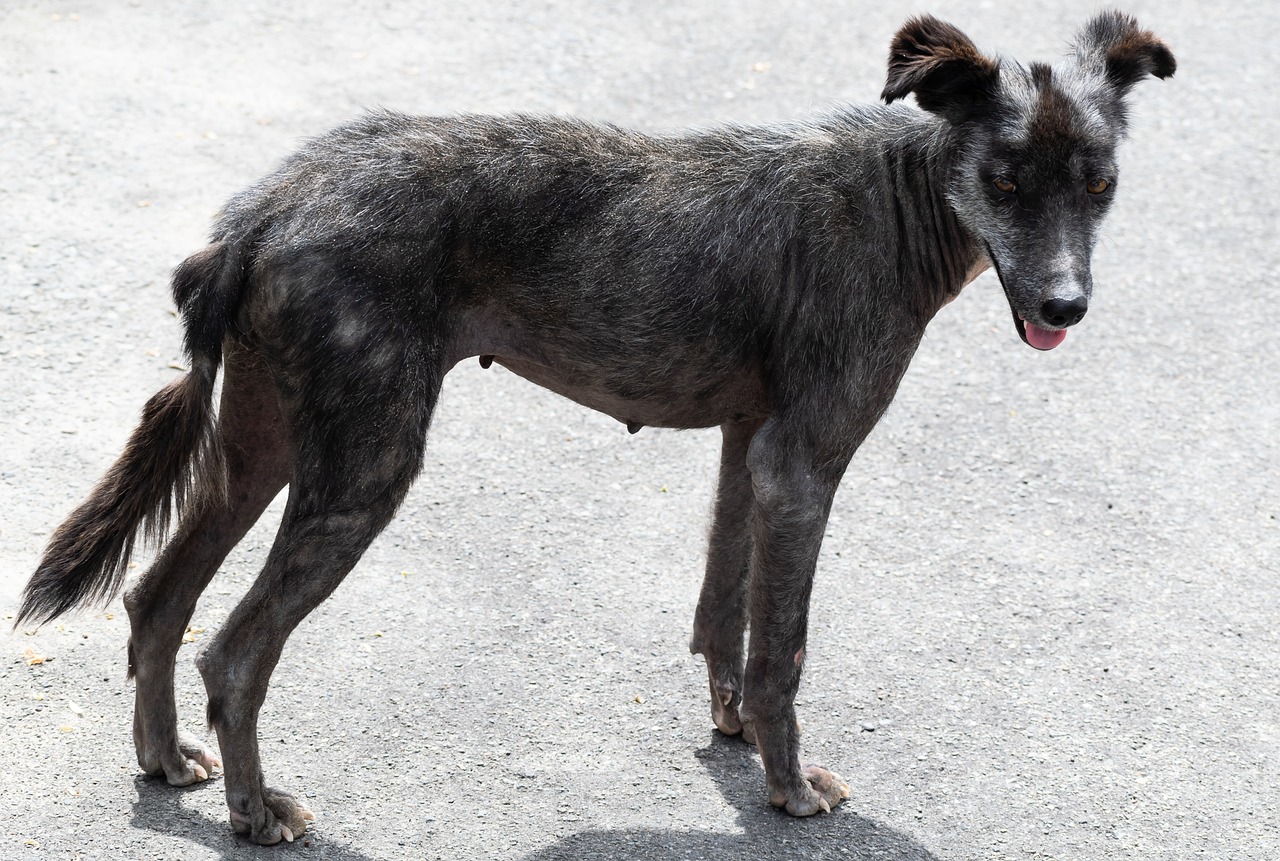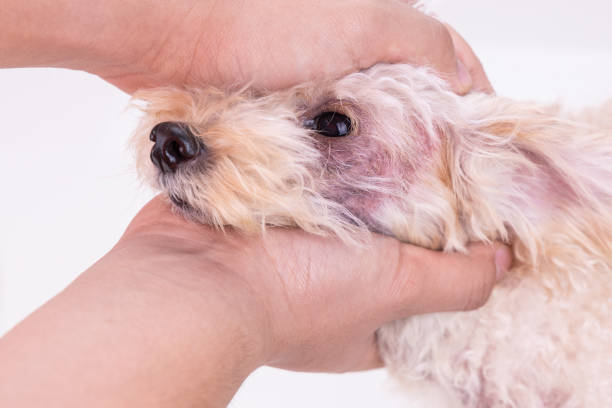Every dog possesses considerable fur coverage. Despite the amount varying with breeds, it’s typically expected that a single dog has approximately 100,000 hair strands. After birth, puppies generally go through a fur development phase lasting 6 to 8 weeks, after which their fur growth regimen restarts. Even though mature dogs might have extended hair growth durations, their fur will inevitably reach the same length as it did in their youth.
Causes of Loss in Dogs’ Hair
There are many reasons why dogs may lose their hair, but the most common cause is a condition called alopecia. Infection, allergies, hormonal imbalance, or parasites like fleas and ticks may cause alopecia. Other causes of hair loss in dogs include:
Genetics
Dogs are known for their furry coats, but many pet owners now see their dogs lose large patches of hair. While there can be many reasons for this, genetics may be the root cause in some cases.
A recently published study found a gene that may predispose certain dog breeds to baldness. The gene, called RSPO2, was found to be more common in boxers and bulldogs who lost their hair than in those who did not.
Infections
Infections are a common cause of hair loss in dogs. Many types of infections can lead to hair loss, but the most common are fungal and bacterial infections. Fungal infections are caused by microscopic organisms that live on the skin and can cause extensive hair loss, especially on the head and tail.
Bacterial infections are caused by bacteria that invade the skin and hair follicles and can cause inflammation and hair loss. Some of the most common bacterial infections that cause hair loss in dogs include pyoderma, folliculitis, impetigo, and cellulitis.
Allergies
Dogs are susceptible to allergies like humans, which can lead to hair loss when allergies flare up. Allergies are caused by a reaction to something the dog’s immune system perceives as a threat, such as pollen, mould, dust, or pet dander.
Allergies include sneezing, watery eyes, itchy skin, and hair loss. If your dog is losing hair due to allergies, you can do a few things to help the dog feel better.
First, talk to your veterinarian about what kind of medication might be able to help relieve your dog’s symptoms. You can also try bathing him more often to help reduce the number of allergens on his skin. And finally, make sure you keep his environment as clean and free of allergens as possible.
Parasites
Dogs are susceptible to a variety of parasites that can cause hair loss. The most common parasites are ticks, fleas, and mites. Ticks are small, blood-sucking creatures that attach to the dog’s skin and feed on its blood.
Fleas are tiny insects that live on the dog’s skin and suck its blood. Mites are tiny creatures that live in the dog’s hair follicles and feed on the dog’s skin. These parasites can cause hair loss in dogs and prevent new hair growth.


Hormone Imbalances
Hormone imbalances are often to blame for hair loss in dogs. Male and female dogs can experience hormone-related hair loss, though it is more common in females. Hair loss can signify that your dog’s hormones are out of balance, which several things, including ageing, obesity, thyroid problems, and other diseases, can cause.
Trauma
While there are many reasons a dog may lose its hair, one of the most common causes is trauma. Trauma can be anything from an accident to surgery. Sometimes, the hair loss is only temporary and will grow back in time. However, in some cases, the hair loss is permanent, and the dog will have to live with it for the rest of its life. If your dog has lost its hair due to trauma, it is important to take it to the vet to ensure there is no underlying medical condition causing the hair loss.
When Should You Expect the Dog’s Coat to Regrow Hair?
Shaved dog hair typically grows back within six to eight weeks. The hair on a dog’s head, muzzle, and legs typically grow back the quickest. Dogs that have been shaved for medical reasons (i.e. to treat a skin condition) may take longer to regrow their hair, depending on the extent of the shave.
What to Do If Your Dog is Losing Hair?
If you’ve noticed your dog is losing hair, the first step is to take him to the vet for a check-up. There are many reasons why dogs lose their hair, from fungal infections and allergies to parasites and cancer. Once your vet has ruled out serious health problems, you can begin treating the hair loss’s underlying cause.
If your dog is itchy, he may need a prescription antihistamine or steroid medication. He’ll need antibiotics if he’s been diagnosed with a skin infection. If parasites cause your dog’s bald spots, you’ll need to kill the parasites with medication or a topical treatment. Finally, if your vet thinks your dog’s hair loss might be due to cancer, she may recommend X-rays or other diagnostic tests.
Treatment for Canine Hair Loss
Hair loss in dogs is a common problem with several possible causes. Treatment depends on the underlying cause.
Treatment for Dog Hair Loss Caused by Nutritional Deficiency
If a nutritional deficiency is responsible, correcting the deficiency may help to restore hair growth. Infections are treated with antibiotics.
Treatment for Dog Hair Loss Caused by Hormonal Imbalances
Hormonal imbalances may be corrected with hormone therapy. Alopecia areata, an autoimmune disease that causes hair loss, can be treated with corticosteroids or other immunosuppressive drugs.
Treatment for Dog Hair Loss Caused by Allergies
Some hair loss cases are due to skin allergies and can be treated with antihistamines or topical steroids.
Treatment for Dog Hair Loss Caused by Parasites
Parasites are tiny organisms that live in or on other living things and can cause various health problems. Dogs can get parasites from contact with other animals, eating infected prey, or drinking contaminated water. One common type of parasite that causes health problems in dogs is mites.
Mites are tiny creatures that live on the skin and hair of dogs and can cause hair loss, skin irritation, and even secondary skin infections.
Suppose your dog is experiencing hair loss caused by parasites. In that case, your veterinarian may recommend a treatment plan that includes medications to kill the parasites and supplements to help improve the condition of your dog’s skin and coat.
Treatment for dog hair loss caused by parasites can be expensive and may require multiple trips to the veterinarian. Still, it is important to seek veterinary care if you suspect your dog has a parasitic infection.
In summary, while the answer to “how long does it take for a dog’s hair to grow back?” may vary depending on the dog, it is generally safe to say that it will take anywhere from four to six weeks for the hair to grow back completely.
If your dog has experienced significant hair loss, consult with your veterinarian to ensure that there is no underlying medical condition causing the problem.



